Healthcare Technology Trends 2025: Exploring Innovations of the Medical Industry
Updated: June 4, 2025
Staying in tune with healthcare technology trends 2025 is more crucial than ever. Yes, legacy systems, with their deeply ingrained roots, remain fundamental to the operations of hospitals and clinics. Yet, now’s the time to think about either integrating them seamlessly with emerging technologies or giving way to more advanced solutions. The goal is simple: improve efficiency, augment performance, and safeguard data, all while ensuring easy access for everyone.
Imagine a patient walking into a clinic, and within moments, the doctor retrieves their medical history from around the globe and is armed with tailored treatment options. Nearby, a robotic assistant performs a delicate surgery with unerring precision. Meanwhile, a hospital administrator browses an intelligent dashboard, using predictive analytics to optimize resources for the next wave of patients.

We provide companies with senior tech talent and product development expertise to build world-class software. Let's talk about how we can help you.
Contact usThis is not a sci-fi movie – this is the healthcare of the nearest future, where technology and medicine are merging in unprecedented ways. The competition is fierce as healthcare organizations are keen on getting a piece of the technology pie.
So, where should hospitals place their bets? Based on Relevant’s 10-year experience building healthcare web solutions, we prepared an overview of the latest healthcare technology trends in healthcare that have the potential to take your organization to the next level.
Table of Contents
Current State of Healthcare Technology
According to Precedence Research, the global market for healthcare information systems, which was already a colossal $332.7 billion in 2024, is expected to rocket to an astonishing $528.5 billion by 2030.

What’s fueling this massive growth? The answer is simple: We need to streamline healthcare processes. No one likes dealing with stacks of paperwork or getting lost in red tape. Governments are jumping in and pushing hard to make healthcare more digital. And the excitement doesn’t end there – tons of new products are also coming out, and companies are partnering to create even more innovative solutions.
Moreover, the global healthcare services market itself is rising. It grew from $7,4 trillion in 2022 to $7,9 trillion in 2023. And it’s predicted to hit $9,8 trillion in 2027. Whether it’s labs, dental care, home healthcare, mental health, or hospitals – everything is growing. For instance, home healthcare alone is expected to reach an incredible $666.9 billion by 2030!
Here’s the best part: All this tech is actually improving people’s lives. Thanks to cutting-edge gadgets and new ways of treating illnesses, people live longer and healthier. A report shows that medical breakthroughs have increased the survival rates for heart attack patients by 70% and decreased the death rates for cancer patients by two-thirds. So, it’s hardly surprising that emerging technology trends in healthcare are making leaps and bounds.
Top 8 Healthcare Technology Trends 2025
Driven by breakneck tech advancements, 2025 promises to be another year of transformative changes in medicine. Below are 8 healthcare technology trends 2025 that we expect to gain traction and help the industry players to combat some of the pressing challenges while innovating care delivery models.
Generative AI
AI is instrumental to many trends right now, but generative AI will be most notably impactful in 2025. One of the key current AI trends, genAI, has taken the world by storm in 2023 due to the rise of such platforms as DALL-E, ChatGPT, and Midjorney. This type of artificial intelligence can create original, realistic content (not just text but also images, music, and programming code).
That said, the automation of administrative tasks will see an additional boost with the adoption of generative AI to streamline clinical documentation and reduce staff burnout. Some of the most promising applications include
- Documentation and record-keeping
- Data entry and extraction
- Appointment scheduling
- Billing and claims processing
- Workflow optimization
- Regulatory compliance checks
Other areas where hospitals can enhance and experience significant short-term benefits from this AI model are medical imaging, drug discovery and development, medical research, and personalized medicine. What’s more, language translation and easier access to medical literature will facilitate medical knowledge and information accessibility. There is no doubt generative AI is a treasure trove of possibilities for the sector and one of the major healthcare technology trends this year.
Chatbots and Virtual Healthcare Assistants
Digital assistants and chatbots will become increasingly integral in supporting doctors by providing guidance on diagnoses, treatments, and medications. They are AI-driven computer applications (usually powered by natural language processing (NLP) and now integrating capabilities of generative AI) that conduct human-like conversations via text, voice, or option-based input.

Available 24/7 online or via smartphones, chatbots in healthcare offer preliminary medical diagnostics and health advice based on user inputs. They can be easily integrated with EHRs and automatically schedule appointments. Virtual healthcare assistants can also help patients adhere to their medications by sending them reminders. Particularly useful in situations where human medical assistants are unavailable, such as during disasters or off-hours, chatbots assist patients in understanding their health issues and guide them toward seeking professional medical help when needed.
Nanomedicine
Nanotechnology is a new scientific field that has sparked a number of breathtaking developments across healthcare with considerable growth potential in 2025. The technology uses microscopically tiny nanoparticles and nanobots, which are hundreds of times smaller than the width of human hair, for a set of medical purposes. These invisible-to-the-human-eye robots can easily and with no hassle move inside our body and perform certain tasks, which makes them invaluable for a number of uses:
- Targeted drug delivery. Nanobots can deliver medication exactly where it’s needed (a cell, tissue, or organ) without affecting healthy cells, as is usually the case with conventional drug therapies.
- Diagnostics and screenings. Once nanorobots are injected into a body, they’re hunting for early indicators of health issues long before symptoms appear.
- Precision surgery. Nanotechnology can assist surgeries during complex operations by delivering medications where they’re needed or taking out strange bodies and harmful materials. So, the surgeries can become less painful, more precise, and faster, while the likelihood of complications will be minimized.
- Cancer care. Nanoscale robots tackle a major challenge in cancer therapy: destroying cancer cells while preserving the surrounding healthy tissue.
- Cronic disease management. Nanotech also proved to be increasingly helpful in managing chronic diseases that require strict following of drug regimes. Nanobots can be programmed to automatically release medicines on schedule.
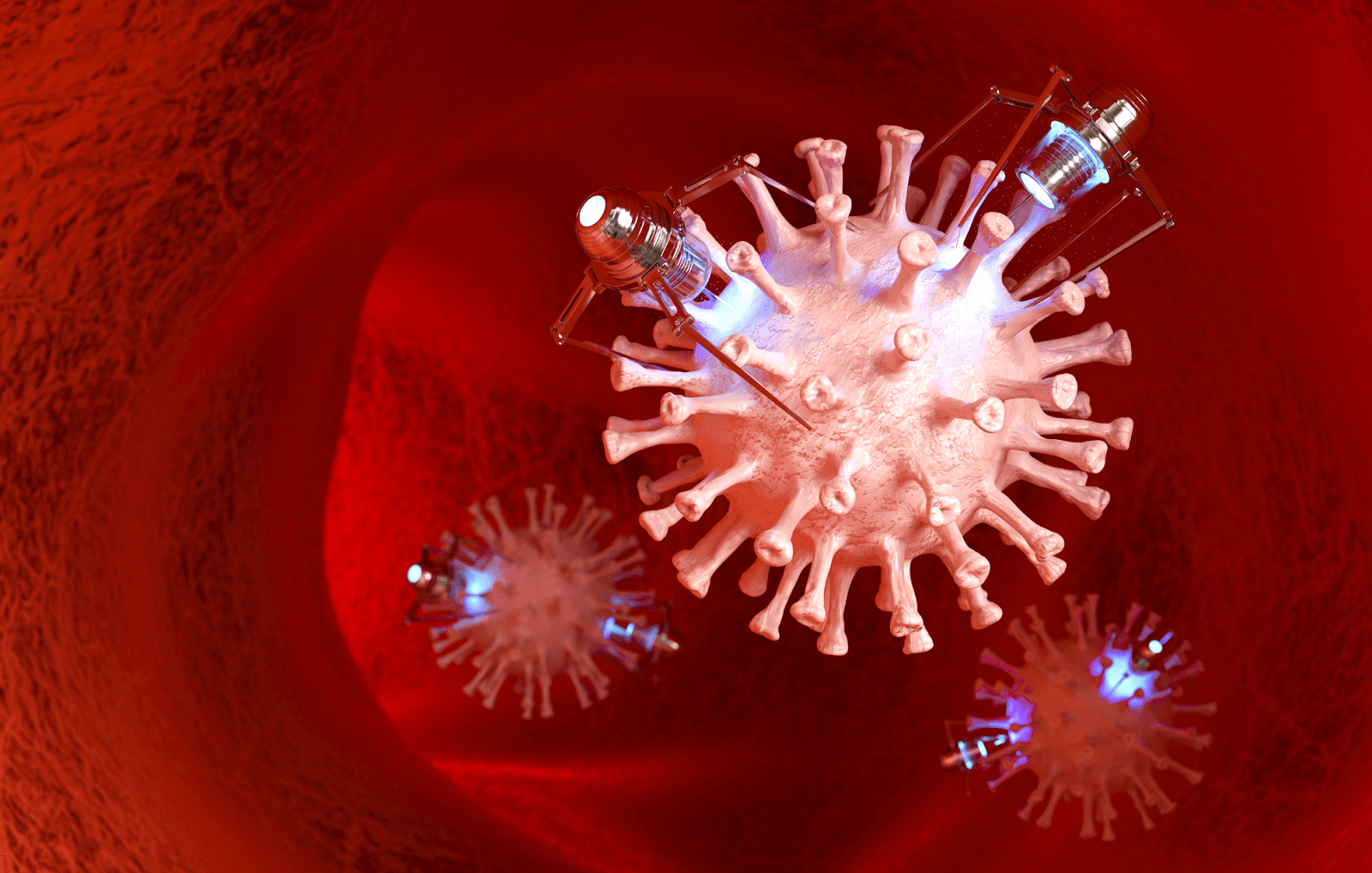
It’s safe to say that nanotechnology is one of the most exciting new medical technology.
Learn more about the incredible opportunities and promising applications of these minuscule robots in our recent article about Nanobots in medicine.
Virtual Reality (VR) and Augmented Reality (AR) in Healthcare
As one of the emerging trends in healthcare technology, these immersive digital solutions are revolutionizing how medical professionals train, diagnose, and provide treatment. With VR, medical trainees can immerse themselves in a digitally constructed environment that mimics real-life scenarios, enriching their learning experience and sharpening their skills. AR, on the other hand, overlays digital information onto the physical world, providing a layer of enhanced reality that can be invaluable in various medical applications.
That’s why one of the standout applications of AR in healthcare is diagnostic imaging. By overlaying CAT scans or 3D images onto a patient’s body, physicians gain a deeper understanding of the underlying issues, allowing for more precise diagnoses. This augmented perspective can be crucial in detecting abnormalities and developing more effective treatment plans.
Meanwhile, VR is making waves, particularly in surgery and physical therapy. Surgeons can employ VR to simulate intricate surgical procedures, allowing them to rehearse and refine their techniques without the risks associated with real-life operations. In physical therapy, VR assists in addressing mental health issues like anxiety and phobias by immersing patients in environments that help them overcome their fears in a controlled setting.
Personalized Medicine and Genomics
The essence of this technology trend in healthcare is tailoring medical treatments to the individual characteristics of each patient. Personalized medicine leverages the power of genomics, big data, and other cutting-edge tech solutions to bring precision and customization to the forefront of patient care.
Genomics involves examining patients’ genetic compositions and pinpointing disease-associated genetic markers. This information helps doctors prescribe treatments finely tuned to the patient’s genetic profile, reducing adverse effects and increasing efficacy. Thus, genomics paves the way for preemptive measures, accurate diagnoses, and tailor-made therapeutic strategies.

Big data also plays an instrumental role in the advancement of personalized medicine. The ability to aggregate, analyze, and interpret extensive datasets from electronic health records and genomic databases is imperative. Big data analytics facilitates population health management by recognizing patterns, assessing risk factors, and identifying health disparities on a granular level.
Organ Care Technology & Bioprinting
Projected to skyrocket to a staggering $30.9 billion by 2030, the global market for organ transplants highlights the critical role these life-saving healthcare technology trends play in the industry.
The essence of organ care technology is to preserve an organ outside the body, essentially extending its viability window. These devices can nourish hearts, lungs, and livers with requisite warmth and nutrients, keeping them for several hours. In the nearest future, AI integration with organ care technology holds immense promise. AI-driven algorithms have the potential to autonomously manage preservation parameters, thereby minimizing human intervention and maximizing organ viability.
Simultaneously, 3D bioprinting is making strides as an innovative solution in regenerative medicine. This technology leverages bio-inks and 3D printing to fabricate living tissues and organs. From creating elementary structures such as cartilage to producing complex organs like hearts and livers, the scope of bioprinting is awe-inspiring.
Virtual Hospitals
This one of the major healthcare technology trends 2025 encompasses technologies that are already known and used in healthcare, such as wearables and telemedicine, that are linked to the Internet of Medical Things (IoMT) network. But, virtual hospital concepts leverage these devices to go beyond basic remote care like video consultations to provide a comprehensive approach to remote patient management and therapy.

A prime example of new technology in healthcare 2025 is the introduction of virtual hospital wards, where a centralized hub oversees the health of numerous patients in the comfort of their homes. Transitioning acute care to home settings, virtual hospitals deliver three major advantages compared to conventional in-hospital care models: increased bed availability, enhanced patient satisfaction and outcomes, and significant cost reductions. It’s also worth noting that patients prefer to receive care in the comfort of their homes over hospital stays.
Digital Twin Technology
Imagine having a virtual replica of a medical device or patient’s anatomy, which can be manipulated and tested in a virtual environment before any real-world application. This is the essence of digital twin technology. By creating precise virtual replicas of medical devices or biological materials, healthcare professionals can conduct exhaustive testing and analysis without the need for physical models. Thus, it fast-tracks the development cycle and significantly reduces costs.
Moreover, this emerging trend in healthcare technology is particularly groundbreaking in personalized patient care. It empowers medical practitioners to fabricate patient-specific digital models of organs or body systems. These models can be invaluable for planning complex procedures, understanding patient-specific risks, and even simulating the outcomes of various treatment options.
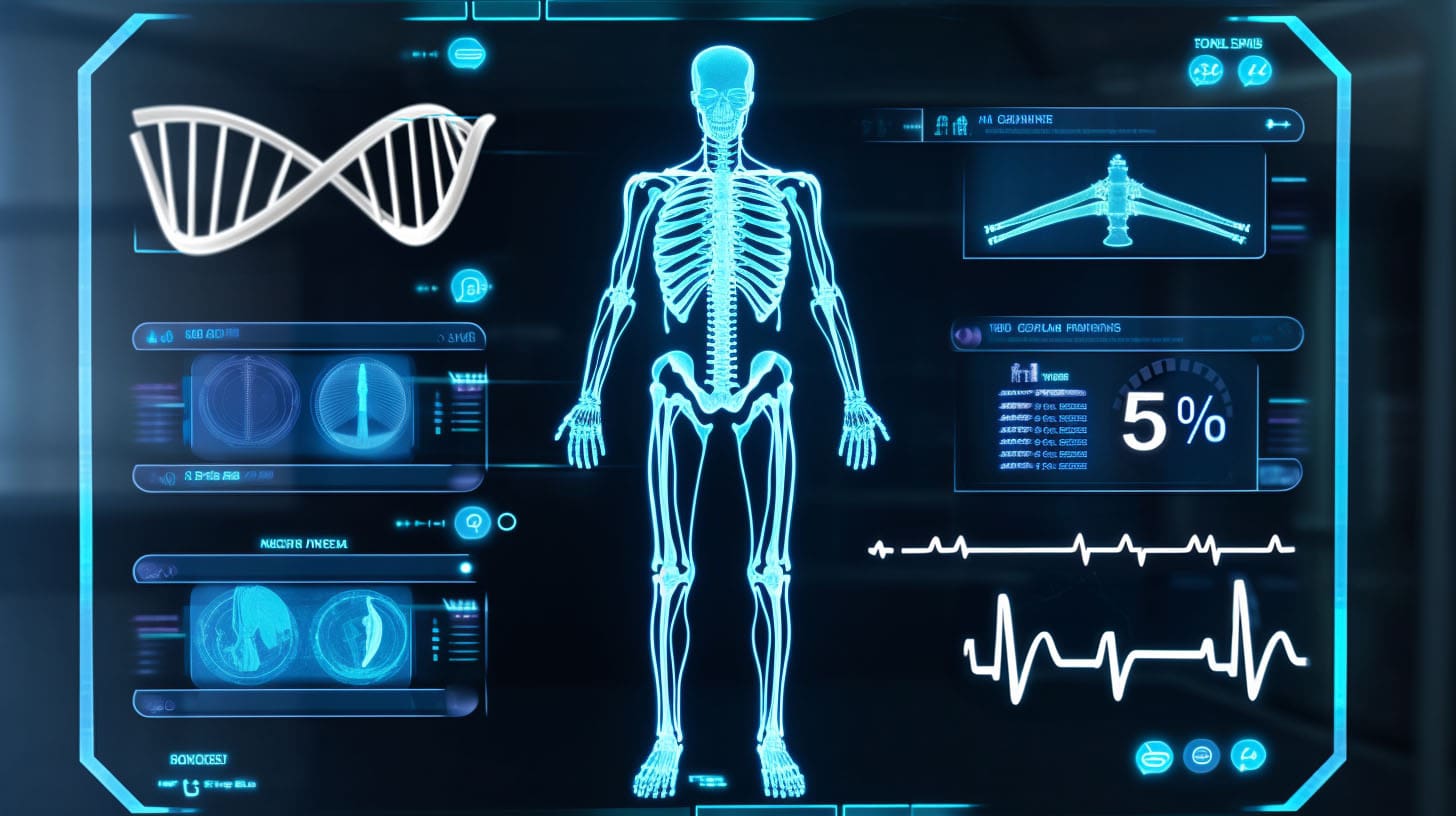
Another benefit of the digital twin in healthcare is its applicability in remote surgeries and telemedicine. By mirroring the patient’s actual condition in a virtual twin, healthcare providers can execute remote procedures with higher precision and confidence. A fascinating aspect of this technology is its enormous potential in clinical research and development.
In essence, digital twin technology is redefining the healthcare landscape by making patient care more precise, enhancing medical device development, and offering endless possibilities in research. Undeniably, this healthcare technology trend is poised to leave a lasting impact.
Previous Top 12 Healthcare Technology Trends
Technology in medical applications offers new opportunities for medical personnel and patients to live in a more sustainable environment and conquer previously incurable diseases. Advanced technological solutions are creating a landscape where sustainability and cutting-edge care go hand in hand. What are the most important healthcare technology trends, and what possibilities do they present? Keep reading to find out.
Electronic Health Records (EHR) and Interoperability
Have you ever thought about the financial side of inefficient healthcare processes? $935 billion, which amounts to 25 percent of all US healthcare expenditure, is wasted, primarily due to administrative complexity, pricing failures, and subpar care delivery.
And now, imagine a healthcare landscape where practitioners are empowered with immediate access to comprehensive patient health records at the click of a button. An Electronic Health Record (EHR) is the current trend in healthcare technology that serves as a centralized repository for patient data, effectively streamlining the information management process. Coupled with interoperability, EHRs take a quantum leap forward. Interoperability ensures seamless communication amongst diverse EHR systems, facilitating the exchange of patient data across various healthcare facilities. Many health centers turn to FHIR to advance interoperability and address the issues of seamless data sharing.
Besides the legal aspect, the technology sets the stage for a paradigm shift from traditional paper-based records to a more agile, interconnected approach. It promises to enhance healthcare delivery through operational efficiencies, reduced redundancies, and data-driven clinical decision-making. A Google Cloud study found that almost 59% of doctors think that better interoperability would help them quickly figure out which patients are at high risk, while an impressive 95% agree that improved interoperability would make patient outcomes better.

Telemedicine and Remote Patient Monitoring
Telemedicine has experienced substantial growth since 2020, providing patients and healthcare professionals with a streamlined approach to consultations. With an impressive 82% adoption rate among consumers since the onset of COVID-19, the market will continue to expand. Current projections estimate the telemedicine market to escalate from $60.8 billion in 2022 to $225 billion by 2030, marking a significant transformation in healthcare delivery.
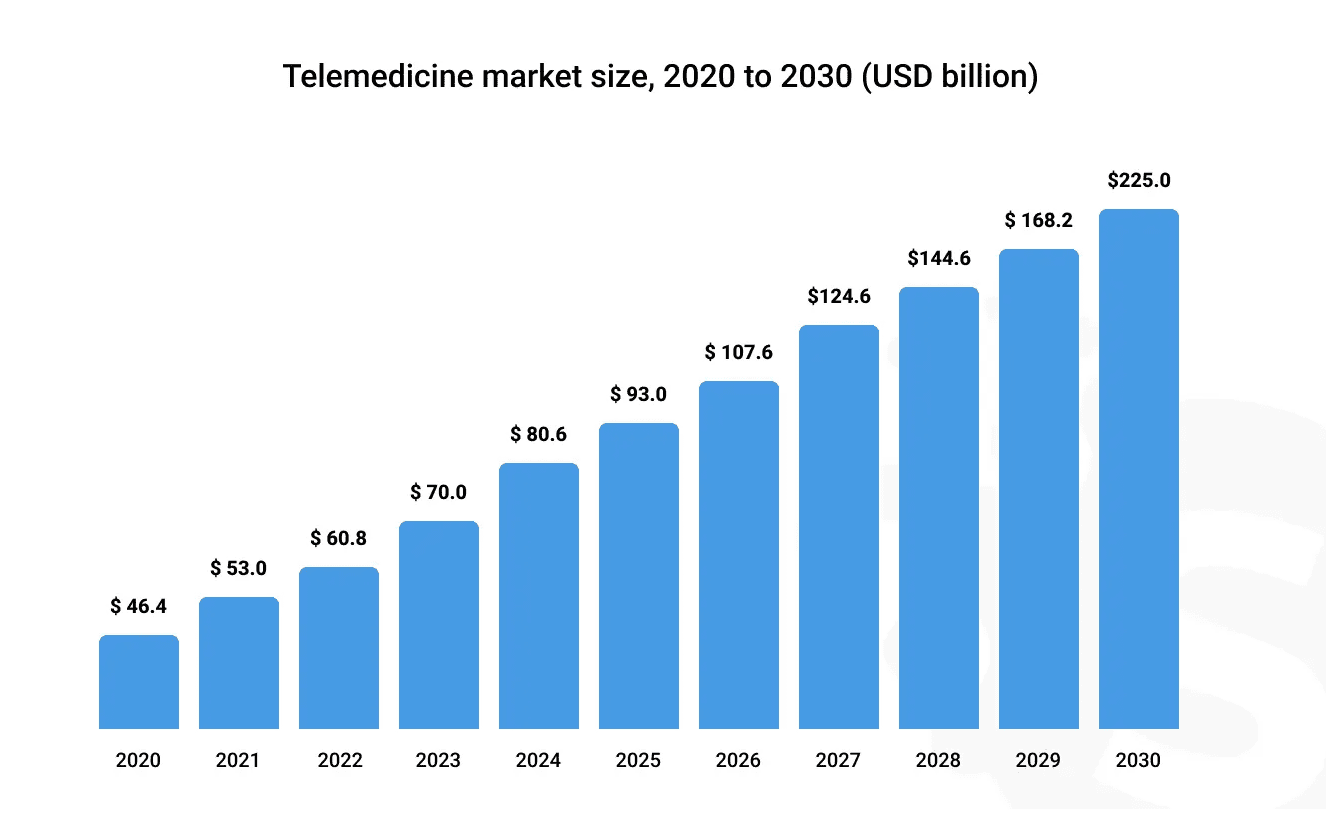
Remote Patient Monitoring (RPM) is becoming an indispensable tool in patient care. RPM enables continuous monitoring of patients’ health data, which is directly transmitted to healthcare providers. That is particularly beneficial for high-risk patients, ensuring timely and efficient healthcare intervention. Market research indicates an upward trajectory for RPM, with the global market expected to reach $175.2 billion by 2027, up from $53.6 billion in 2022.
These technologies are not only enhancing patient experience but are also optimizing the operational efficiency of healthcare institutions. As these trends in healthcare technology continue to mature, they will play an increasingly integral role in shaping the future landscape of healthcare services.
Artificial Intelligence (AI) and Machine Learning (ML) in Healthcare
These technology healthcare trends are transforming how medical professionals make decisions, manage patient data, and provide care. AI and ML excel at processing enormous amounts of data, spotting healthcare technology trends, and serving up insights critical for diagnosis and treatment.
AI is proving to be indispensable for a plethora of applications. For instance, it’s enhancing the precision and scope of diagnostics. Traditional cancer diagnosis methods, such as biopsies, were often limited. Now, with AI-powered whole-slide imaging, pathologists can examine extensive tissue areas, which is critical for understanding diseases like cancer. This not only accelerates the diagnostic process but also improves its accuracy.
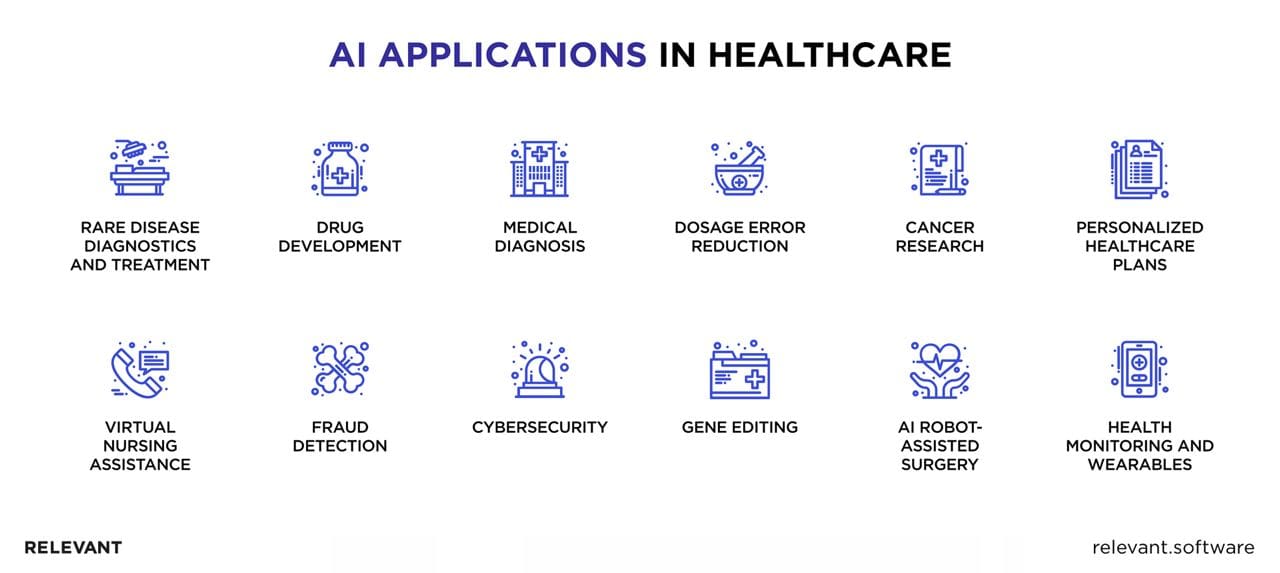
Meanwhile, Machine Learning, a subset of AI, is instrumental in analyzing complex data such as CT scans, which is particularly relevant in addressing challenges like the COVID-19 pandemic. Moreover, ML algorithms are leveraged to predict patient readmissions, enhance clinical workflows, and even forecast disease outbreaks.
The scope of these technologies is vast and ever-expanding. Interested in practical applications? Check out this guide on How to Implement Machine Learning in Healthcare: 6 Real Cases for real-world examples and insights.
Internet of Medical Things (IoMT) and Wearable Devices
As one of the latest technology trends in healthcare, IoMT transforms healthcare delivery and management by creating a connected ecosystem that allows for the seamless monitoring and analysis of health data.
IoMT is no longer a novelty but a reality in the present healthcare sector. The global IoMT market, valued at $180.5 billion in 2021, is expected to skyrocket to around $960.2 billion by 2030. It offers a spectrum of digital health advancements that make life easier for medical professionals, translating into substantial cost savings. Wellness and remote health monitoring apps are already in wide use.
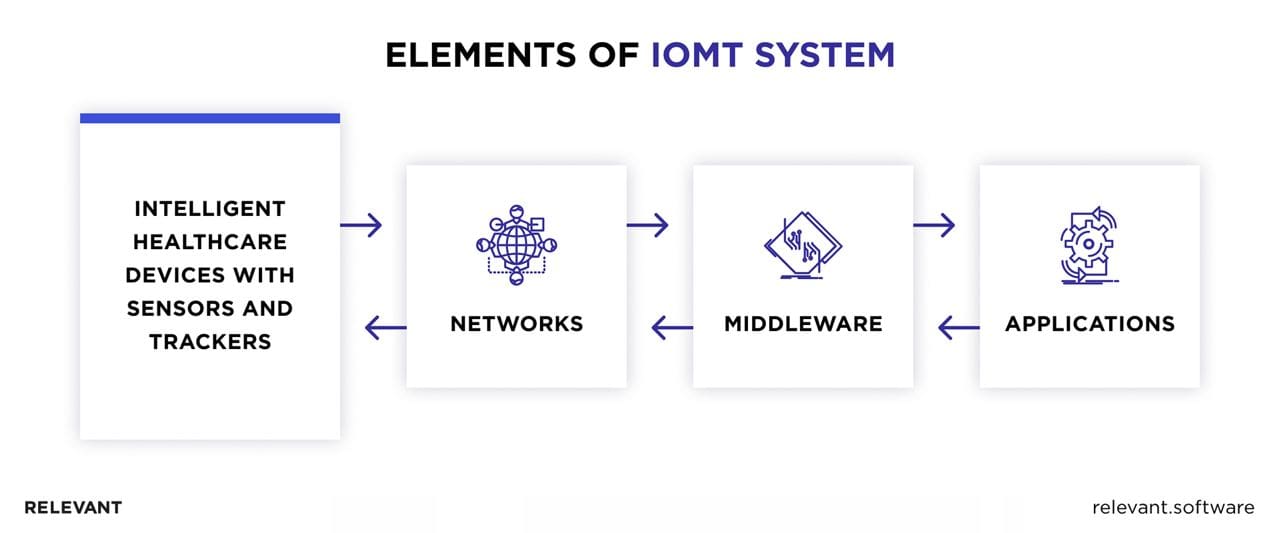
Many of these apps are compatible with wearable devices such as fitness trackers and heart rate monitors. These devices provide real-time, detailed information about a patient’s health. They collect data through sensors placed on the body, giving valuable insights into vital health metrics like pulse, body temperature, blood pressure, and more.
Thus, healthcare professionals can track patients’ health more accurately and build personalized treatment plans. On the patient’s side, using these devices fosters a greater awareness of personal health. With access to real-time data, individuals can better understand their sleep patterns, eating habits, activity levels, and other health-related behaviors.
Biotechnology
Another equally impactful and likewise fascinating healthcare innovation is biotechnology. It’s an emerging field where biology meets tech, aimed at developing new health-improving products and solutions. In 2025, we can expect to see biotechnology progress and bring advancements in custom-fit medicine, gene and cell therapies, and even speed up drug development.

Biotechnology targets the development of personalized treatments tailored to a patient’s genetics and lifestyle, which result in more effective care with fewer side effects. It can also accelerate drug discovery through innovative techniques like structural biology, bioinformatics, and high-throughput screening. And let’s not forget how it’s changing the game in vaccine development with mRNA and recombinant DNA tech.
Blockchain in Healthcare
Protecting sensitive patient information is currently the most widespread use of blockchain in care services, and it’s easy to see why. To put this into perspective, 692 sizable healthcare data breaches were reported in the one year from 2021 to 2022. Blockchain addresses this by encrypting patient records in a decentralized manner that is virtually tamper-proof. While the data within the chain is visible and verifiable, the identities of individuals are safeguarded using sophisticated codes. This combination of transparency and anonymity is a safe haven for sensitive medical data.
Additionally, blockchain simplifies access to patient records. Through a unified ecosystem, healthcare providers can effortlessly retrieve accurate patient data. This not only saves time but is instrumental for informed decisions regarding diagnoses and personalized care.
Blockchain is also transforming the pharmaceutical supply chain. With the ability to record and monitor the entire lifecycle of a drug, from its origin to the consumer’s hands, blockchain instills an unmatched level of transparency. It ensures that every interaction with the drug is logged, right down to the environmental impact during shipping.
Edge Computing in Healthcare
Edge computing technology will become more prevalent within hospitals due to the growing use of AI and IoMT, and virtual hospitals in particular. Rather than sending data to a centralized location of processing (cloud service providers), it happens at the edge of the network or, in the case of healthcare facilities, at the point of care.
Edge computing will allow hospitals to deliver faster and more responsive services. Medical organizations implementing IoMT solutions for remote care monitoring will benefit from near real-time data analysis that will drive timely medical interventions. Better patient outcomes and improved care delivery are just a few aspects hospitals can enhance using edge computing.
Robotics and Automation in Healthcare
With the escalating demand for healthcare services and an impending global healthcare worker shortage, robotics and automation are new healthcare technology trends that are robust solutions to these challenges.
RPA utilizes bots equipped with capabilities to mimic human actions to streamline repetitive and time-consuming tasks. This technology can automate diverse processes like inputting data, booking appointments, and handling insurance claims.
Not only does RPA promote operational efficiency, but it also alleviates the workload on the healthcare workforce. Automating routine tasks allows health personnel to concentrate on patient care and critical decision-making. Importantly, RPA aims not to replace the human force but to enhance their efficiency and productivity.

Moreover, automation is making a splash in surgery with robots that can perform intricate procedures with high precision. It reduces surgical complications and recovery times, ultimately improving patient outcomes.
Mobile Healthcare
The National Library of Medicine notes that 75% of hospitals now offer mobile app access, a clear indicator of mHealth’s growing role in medicine. Today, it’s hard to find someone without a smartphone. We use it for just about everything, so it’s hardly surprising that mobile technology is making big waves in healthcare. Think about it – we’re already glued to our phones, so why not use them to keep tabs on our health, too?

With over 96,000 mobile health (mHealth) apps available on major Google Play and AppStore platforms, according to Statista, their variety is vast:
- Telehealth apps
- Medication management apps
- Patient portals
- Fitness and wellness apps
- Chronic disease management apps
- Mental health apps
- Appointment scheduling and reminder apps
Impressively, about two-thirds of US adults have mHealth apps on their smartphones, with 60% using them daily, according to Insider Intelligence. So, if you want to increase accessibility to health services and improve patient outcomes while enjoying seamless access to medical records, it’s worth considering developing a mHealth app.
Predictive Analytics in Healthcare
As one of the most groundbreaking healthcare technology trends, predictive analytics analyzes vast datasets to extract invaluable insights, leading to enhanced clinical outcomes and operational efficiencies.
Predictive analytics’ main advantage is the capacity to foresee patient needs and trends. Employing sophisticated algorithms, it detects patterns in historical data and predicts potential health risks. For instance, by examining a patient’s health records and lifestyle choices, healthcare professionals can estimate the probability of chronic diseases and tailor preventive interventions accordingly.

For healthcare organizations, predictive analytics is an asset that plays a pivotal role in resource management, optimizing staff allocation, and supply chain operations. This results in enhanced patient care and substantial cost reductions. The dynamic forecasts of demand for medical supplies enable the efficient utilization of resources, mitigating the risk of overstock or shortages.
Focus on the Mental Health Care
The recent proliferation of digital tools designed to cater to ongoing mental health needs marks a significant stride in patient-centric care. Telepsychiatry has emerged as a game-changer, leveraging technology to deliver mental health services through video calls and messaging.
Another noteworthy benefit of telepsychiatry is its potential to weaken the stigma associated with mental health. Traditional face-to-face conversations regarding mental health can be anxious for some; telepsychiatry offers a layer of privacy that can be reassuring.
Another solution is mental health apps that serve as accessible tools for individuals seeking to manage and improve their mental well-being. These apps often include self-help resources such as mood tracking, meditation guides, and stress reduction exercises, which empower individuals with self-care strategies. Significantly, some apps connect users to licensed therapists for virtual consultations, breaking down barriers to professional care.
Big Data Analytics
Big data stands among the most transformative technologies, which helps medical organizations benefit from the data they collect every day. Notably, the healthcare sector is the primary source of the world’s data, generating nearly a third of all the global data. So, no wonder hospitals can gain a lot with big data technology. Using big data analytics software and tools, healthcare professionals can extract valuable insights from the information they already possess in the following ways:
- Examine patient records, genetic data, and medical imaging to support diagnostics and treatment development
- Customize treatments and therapies based on patient information for improved effectiveness and lower adverse reactions
- Predict potential health hazards, patient prognoses, and disease outbreaks by discovering certain patterns and correlations in healthcare data
- Observe broader health trends in populations, track shifts in epidemiology situations, and build strategies to prevent the spread of diseases.
Future of Healthcare Technology Trends
Future technology trends in healthcare will redefine the very structure of the medical industry. The convergence of innovation, data, gamification, and patient-centric care is paving the way for a revolution that goes beyond conventional boundaries. From predictive analytics and personalized medicine to digital twin and mental health apps, the top healthcare technology trends are forging a path that brings quality, efficiency, and agility to patient care.
However, navigating this ever-evolving landscape calls for partnership with those who understand the nuances of healthcare and have the technical prowess to turn visions into reality. Our expert team at Relevant Software is well-versed in developing robust healthcare IT solutions that cater to your unique requirements.
Whether you’re seeking insightful healthcare IT consulting services or looking to harness the potential of emerging trends, we’re committed to delivering cutting-edge healthcare software solutions that are tailored, scalable, and geared toward making a meaningful impact. Сontact us, and let’s collaborate to elevate your healthcare services to unparalleled heights.
FAQ
Our core services:
Do you want a price estimate for your project?
Do you know that we helped 200+ companies build web/mobile apps and scale dev teams?
Let's talk about your engineering needs.
Write to us












